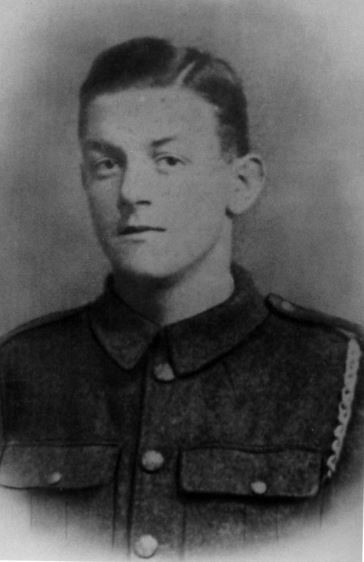Pte
Charles Francis Quarterman
Informations sur naissance
|
Date de naissance: 04/09/1898 |
|
Lieu de naissance: Elcot, Berkshire, Angleterre, Royaume-Uni |
Informations générales
|
Profession: Ouvrier |
Informations service militaire
|
Pays: Angleterre, Royaume-Uni |
|
Force armée: British Expeditionary Force |
|
Rang: Private |
|
Numéro de service: 203846 |
|
Incorporation nom de lieu: Newbury, Berkshire, Angleterre, Royaume-Uni |
|
Unités: — Princess Charlotte of Wales’s (Royal Berkshire Regiment), 1/4th Bn. (Dernière unité connue) |
Informations sur décès
|
Date de décès: 16/08/1917 |
|
Lieu de décès: St Julien, Belgique |
|
Cause du décès: Killed in action (K.I.A.) |
|
Âge: 18 |
Mémorial
|
Tyne Cot Memorial Panneau: 106A |
Distinctions et médailles 2
|
British War Medal Médaille — 15/10/1920 |
|
Victory Medal Médaille — 15/10/1920 |
Points d'intérêt 3
| #1 | Lieu de naissance | ||
| #2 | Lieu d'enrôlement | ||
| #3 | Lieu du décès (approximatif) |
Mon histoire
Charles Francis Quarterman was born in 1898 and was the second son of Leonard and Elizabeth Quarterman, of Peasemore, Berkshire. Before the war, Charles worked as a labourer in Farnborough. He enlisted in Newbury, following his older brother Albert, who already served in the army. By the summer of 1917 Charles served as a Private in the 1/4th Batalion Royal Berkshire Regiment, part of the 145th Brigade, of the 48th (South Midland) Division.
The 48th Division’s first action in Flanders was the Battle of Langemarck, a stage in the Battle of Passchendaele. On 16 August 1917 it attacked near the village of Sint-Juliaan, with the 145th Brigade. The 1/4th Berkshires were in reserve and were designated to move to the final objective. When the assaulting Battalions moved towards the Langemarck road, the Companies of the 1/4th Berkshires followed them, supporting their attack wherever they could.
Overall the attack of the 48th Division was an utter failure. It faced a well defended network of three consecutive positions, protected by intermediate strongpoints. With almost no artillery support and the absence of tanks, the men made little headway. They could only make a dent in the German positions along the Langemarck road, around Springfield Farm, but were soon forced back. The Companies of the 1/4th Berkshires were in support of the assaulting Battalions and because the attack didn’t develop as planned, they did not need to advance to their objective. Remaining stationary for the most part of the attack, the Battalion was frequently shelled by the German artillery, suffering severe casualties.
Private Charles Francis Quarterman was killed in action on 16 August 1917 during the attack at Sint-Juliaan. He fell three weeks before his 19th birthday. Charles’ remains were never found or weren’t identified and he is remembered at the Tyne Cot Memorial.
The 48th Division’s first action in Flanders was the Battle of Langemarck, a stage in the Battle of Passchendaele. On 16 August 1917 it attacked near the village of Sint-Juliaan, with the 145th Brigade. The 1/4th Berkshires were in reserve and were designated to move to the final objective. When the assaulting Battalions moved towards the Langemarck road, the Companies of the 1/4th Berkshires followed them, supporting their attack wherever they could.
Overall the attack of the 48th Division was an utter failure. It faced a well defended network of three consecutive positions, protected by intermediate strongpoints. With almost no artillery support and the absence of tanks, the men made little headway. They could only make a dent in the German positions along the Langemarck road, around Springfield Farm, but were soon forced back. The Companies of the 1/4th Berkshires were in support of the assaulting Battalions and because the attack didn’t develop as planned, they did not need to advance to their objective. Remaining stationary for the most part of the attack, the Battalion was frequently shelled by the German artillery, suffering severe casualties.
Private Charles Francis Quarterman was killed in action on 16 August 1917 during the attack at Sint-Juliaan. He fell three weeks before his 19th birthday. Charles’ remains were never found or weren’t identified and he is remembered at the Tyne Cot Memorial.
Sources 3
|
145 Infantry Brigade: 1/4 Battalion Royal Berkshire Regiment (Princess Charlotte's), (The National Archives, KEW (TNA), WO 95/2762/4). https://discovery.nationalarchives.gov.uk/details/r/C14303 Autre référence |
|
Cruttwell C., The War Service of the 1/4 Royal Berkshire Regiment (T.F.), (Oxford, Basil Blackwell, 1922), pg. 120-126. Sources utilisées |
|
McCarthy C., Passchendaele. The Day-by-Day Account, (London, Uniform, 2018), pg. 54-55. Sources utilisées |
Complément d’informations 3
|
Commonwealth War Graves Commission Database https://www.cwgc.org/find-records/find-war-dead/casualty-details/830053 |
|
Namenlijst (In Flanders Fields Museum) https://namenlijst.org/publicsearch/#/person/_id=1aeadf3f-ca8c-4a6e-8bf8-434ef8279eae |
|
Lives of the First World War (Imperial War Museum) https://livesofthefirstworldwar.iwm.org.uk/lifestory/3629634 |
